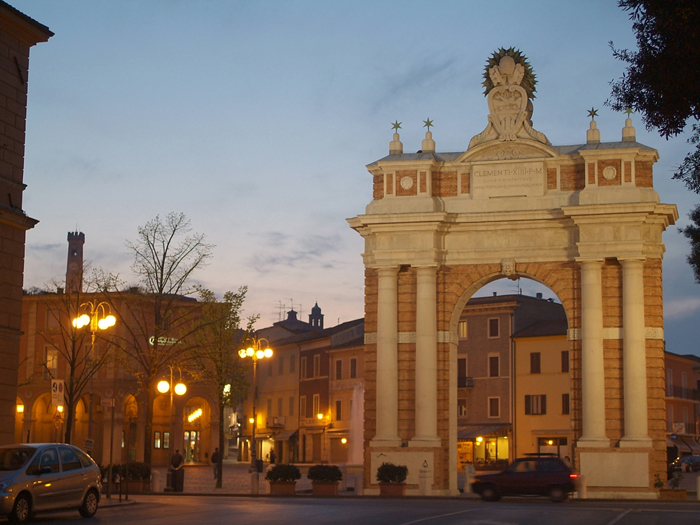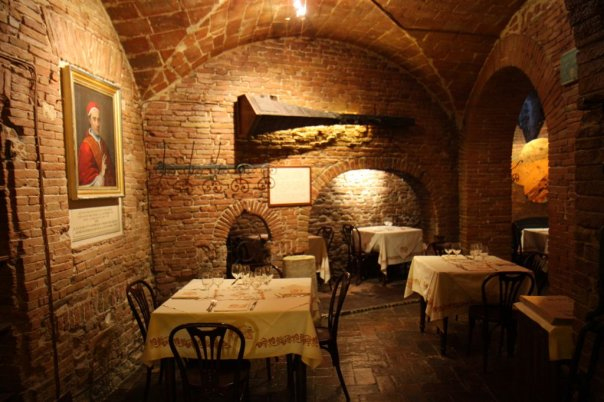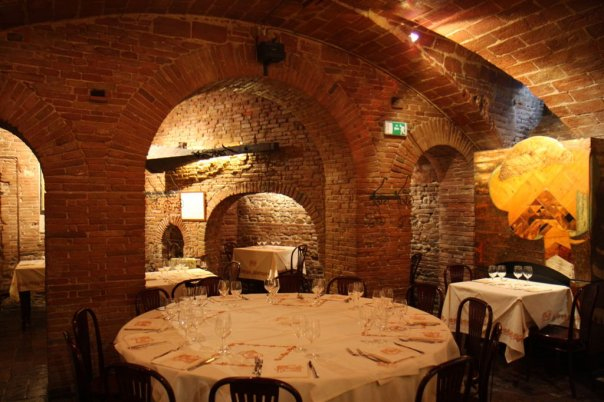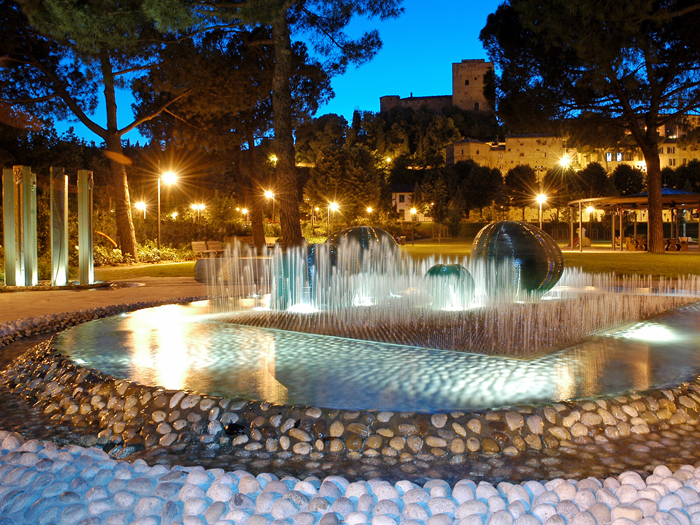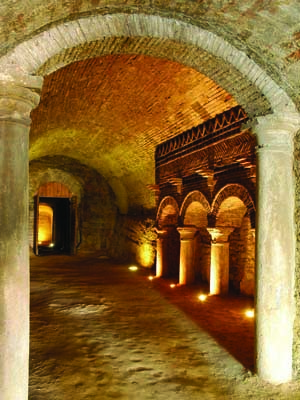 Local legends maintain that Sangiovese, one of Italy’s best loved red wines, can trace its origins to Santarcangelo di Romagna, and many experts agree. The position of Santarcangelo’s medieval centre is 10km inland from Rimini on the Colle Giove hill – named after the ancient god Jove. This led, it seems, to the wine being known as sanguis Jovis – blood of Jove.
Local legends maintain that Sangiovese, one of Italy’s best loved red wines, can trace its origins to Santarcangelo di Romagna, and many experts agree. The position of Santarcangelo’s medieval centre is 10km inland from Rimini on the Colle Giove hill – named after the ancient god Jove. This led, it seems, to the wine being known as sanguis Jovis – blood of Jove.
Nowhere could be more fitting a home for such a widely appreciated wine than the vibrant and highly hospitable town of Santarcangelo, where culture and a respect for tradition go hand in hand with delicious food and excellent wine. The charming medieval hilltop town has a seductively pretty skyline and a bustling knot of pedestrianised streets at the base of the hill, where independent shops specialise in everything from hats and household goods to coffee and shoes.
WALKING THE STREETS
Il combarbio, the busy heart of daytime Santarcangelo, is the spot where five pedestrianised streets meet; it’s marked by an ancient mooring bollard perched atop a millstone –
a curious monument symbolising
the historic importance of both the land and the sea. From here the
view in one direction (along Via
Don Minzoni) pans straight to
the fairytale triple peaks of San Marino; turn instead to look up
the steps to the medieval centre and you see the characteristic clock tower at the top of the town.
Known as il campanone, the 25m high tower was built in 1893 to replace a previous one which had collapsed. It’s a major landmark, visible for miles around, and the bell rings out every quarter, keeping the locals in step. Piazzetta Galassi, where the tower stands, was at once the main square, with the town hall, chemist (the symbol is still visible over the door) and osteria, where farmers and merchants would convene to talk business, no doubt over a carafe of local Sangiovese.
The Capuchin friary here at the top of Colle Giove is the scene of the story behind the name of Sangiovese: an illustrious guest complimented the friars on their exquisite wine and asked what it was called. Eager to please yet never having given the wine a name, one of the friars declared it to be sangue di Giove, blood of Jove, in honour of the hill they called home. The cypress-lined approach to the friary has some fantastic views over the town.
A stroll around the attractive high part of town with its rows of picturesque houses and breathtaking panoramas of the surrounding countryside is charming at any time of day, but when the sun sets it really comes to life: the numerous hostelries open up, the air fills with the aroma of good food and the lamp lit cobbled lanes take on an extra romance.
A LOVE AFFAIR
Back in the 13th century, romance turned to tragedy in Santarcangelo for one young couple, Paolo and Francesca, who are mentioned in Dante’s Divine Comedy. Pretty Francesca was tricked into marrying the wicked and ugly Gianciotto of the ruling Malatesta family when she believed herself to be pledged to his brother Paolo Il Bello. Returning from battle one day, Gianciotto discovered the pair of lovers and wasted no time in murdering them. Although several other local castles lay claim to the story, Santarcangelo’s Rocca Malatestiana castle is considered by most to be the true site of the tragedy. Privately owned, the castle opens to the public on the afternoon of the first Saturday and Sunday of each month – vagaries of the rather over-protective and unpredictable guardian permitting.
As Massimo Berlini, tour guide and owner of the Grotta dei Piaceri shop, recalls, “when I was young we used to head for the coast if we wanted a good night out, but nowadays everybody comes here!” The majority of Santarcangelo’s many bars and eateries are only open in the evenings – several into the early hours – but they all combine great food and friendly, atmospheric surroundings, thanks to the enormous pride everyone round here seems to have in their town.
TASTING THE CULTURE
One restaurant not to be missed, almost as much for the interior, which is a kind of living museum-piece, as for the fabulous food, is La Sangiovesa. From the moment you enter and Daniele, the head waiter, invites you to help yourself to wine and piadina (the delicious local flatbread) it’s like a full-immersion in local culture. Each of the ten rooms is themed around a particular aspect of the town, including the Malatesta dynasty, Guido Cagnacci (the renowned 17th-century artist born here) and Pope Clemente XIV, also from Santarcangelo, who was allegedly poisoned by the Jesuits after attempting to suppress the order.
La Sangiovesa includes an informal osteria section, with simple dishes such as filled piadina and meat or cheese platters, while the main restaurant also serves homemade tagliatelle, gnocchi and so on as well as a wider range of meat dishes. Chef Massimiliano Mussoni first worked here as a teenager, returning to take charge of the kitchen team 13 years ago. He stresses the importance of quality ingredients: “We’re lucky as we have our own farm, Tenuta Saiano, nearby in Montebello. I go regularly to monitor things and ensure everything is produced in the best way possible.”
Most of the meats, including chicken, duck, pigeon, rabbit, salami and ham are from the farm, as is the olive oil and red wine (Sangiovese of course). What isn’t their own is sourced at carefully selected local producers. The flour, for example, is stone-milled at a nearby watermill, one of a total of 165 that once functioned in the Marecchia valley. The town itself had several mills which were served with water from
a canal that flowed along Via Battisti; they were used on route by the fish market and print shop.
Particularly interesting is Stamperia Marchi (Via Battisti 15), the print shop where ancient methods are still used to create beautiful fabrics handprinted with traditional designs. Fabric is smoothed by
a huge 17th century wheel press before the designs are applied using handcarved pearwood moulds dipped in dye, typically rust-coloured. Popular designs include vines, ears of wheat and caveje – the good luck symbol of Romagna, a decorative metal rod used to attach an ox yoke to the cart. La Sangiovesa restaurant has personalised tablecloths hand-printed by Marchi, and a wall-full
of historic caveje.
POETIC TRADITION
Before leaving La Sangiovesa visit the underground cave, one of over 150 below the town. The majority of these man-made caves are thought to have been for storage – the constant temperature of around 13°C is ideal for Sangiovese – but several of the larger ones continue to be a mystery, many theories attributing them to religious uses. Cave tours leave regularly from the tourist office, which is found on Via Battisti 5.
One other feature of Santarcangelo that may have you guessing even if your Italian is word-perfect, is the selection of dialect poems on display around town. Often amusing, bittersweet or ironic, the poems don’t always come with an Italian version, but there’s usually
a local resident on hand to provide a translation. The age-old phenomenon of Santarcangelo’s dialect poets continues to thrive, although one of the most celebrated, Tonino Guerra, died last year. His main career as a screenwriter won him an Oscar for Federico Fellini’s Amarcord in 1975.
Santarcangelo’s poetry scene is what gave the name to the Collina dei Poeti (Hill of the Poets; www.collinadeipoeti.it) vineyard just outside the centre. Sauro Torsani, one of the vineyard’s three partners, explains, “when we were kids this estate belonged to a well-known politician; it was an immense satisfaction to save it from abandonment.” The estate’s first and principal wine, Teatro 40, is a Sangiovese named in honour of the 40th anniversary of the town’s international festival of experimental theatre, held each July.
“We’ve donated a piece of land to an association for disadvantaged youth and we buy back some of the vegetables they grow to cook for our events,” adds Sauro. “There’s something going on nearly every weekend here, always involving local food and wine – we have a wonderful time.” A wonderful time – that sums up perfectly any visit to Santarcangelo, birthplace of Sangiovese. Salute!

